From start to finish—Part 1: The research
Every week the Tremendousness creative team meets to share ideas, seek help, and get feedback. Sometimes we shows works-in-progress, sometimes we talk about interesting side projects or links we’ve come across. Often, we discuss possible passion projects. 95% of the time, these things don’t go anywhere because of our client workload, family life, etc. It can be fun but frustrating—and it’s not a problem unique to us. Like everyone, we have more ideas than time.
But sometimes you just make the time, like with Scott’s “The Sugary Truth” video or Chris’ “OK, so what the heck is kombucha?” infographic.
Last year we decided we would do something for the Gateway Arch’s 50th anniversary. That’s just too big a deal to let pass, and the Arch is too cool a monument to ignore. There are plenty of infographics out there on the Arch–but we wanted to do something big, something comprehensive, something beautiful, and something that had at least a fraction of the “Wow” you get when you look at the Arch itself. We decided to design a poster. This is the story of that.

Part I of V: The research

Once you’ve got an idea, you’ve got to do your research next. We did lots of it—everywhere from the National Park Service to books to Wikipedia to fan sites to academic papers to blog posts to news articles to in-person visits. As the new year began I gathered a huge amount of info, put it into Google Docs, and started to sort it, looking for patterns and ways to chunk important facts and interesting trivia. Our friend Sarah Truckey helped edit and organize a good amount of content in these early stages—thank you!
In many ways, this is the most difficult part of a project. We can write, we can design, we can draw. But what do we know about arches, architecture, or anything? In most cases, not much—so you’ve got to get informed, and quickly. With clients, we do this via Discovery Sessions. Sometimes they’re in person and sometimes they’re online meetings. Either way, we get together with experts and ask questions and begin to turn their words into pictures. But in this case, we’re our own client—so it’s all on us.
Like all big projects, there’s no simple formula for a good outcome except to 1) Start the work; 2) Do the work; 3) Do it as well as possible. These tips can only help with that last part—the rest is up to you.
- START WITH A PURPOSE, NOT A GOAL, IN MIND. Keep that mind of yours open. Why are you doing this, instead of what do I want to say? Basically this: “I want to tell the story of the Arch.” And not this: “I want to tell everyone how awesome the Arch is.” That might seem subtle, but it’s important to keep an objective perspective. Act like a journalist.
- DON’T BELIEVE EVERYTHING YOU READ ON THE INTERNET. To some people, research just means remembering a story they once heard. Make a serious effort to find the original source of your facts. Evaluate your sources. Be skeptical.
- GET REAL-LIFE EXPERIENCE WHEN POSSIBLE. Visit important places and talk to knowledgeable people. Google (er, Alphabet) may be omnipotent, but it’s not omniscent.
- BEGIN BROADLY, FINISH FOCUSED. Let everything in at first. Then, once you have your preliminary research completed, try to narrow the focus and find an interesting angle or perspective get more detail on. Admittedly, our Arch story stayed pretty broad—but our goal was broad as well. We could have focused just on the construction, or the Arch in pop culture, or its cultural impact and still told an interesting story.
- ORGANIZE YOUR MATERIAL. Do something, anything, to keep all that different information from disparate sources organized. Paper folders on a table. Google Docs online. Index cards on a desk. Categorized links in Delicious or Pinboard. Sticky notes on a wall. Diagrams on a whiteboard. You’re going to have a lot of stuff, and if it’s all in one big unsorted pile you’re going to spend a lot of time re-searching rather than researching.
- START SKETCHING EARLY. Just because you’re in the research phase doesn’t mean you can’t start visualizing the information. Better to capture your ideas than to let them get away. Just remember these sketches aren’t yet solutions, they’re just more material.
- DOUBLE CHECK, THEN TRIPLE CHECK THOSE FACTS. Best to get someone else to do this for you—fresh eyes and all that.
- TRACK YOUR SOURCE REFERENCES. You’re going to want to easily go back later when doing that fact-checking. In fact, I did a poor job of this on this project and made my fact-checker’s job much more difficult than it should have been. Now I’m filled with shame.

Every new project we work on is a learning experience—and for us learning usually is fun.
But it’s especially fun when you’re learning about 630-foot-tall stainless steel arches.
Coming next—Part II of V: The concept.
The above Eero Saarinen arch sketches courtesy Yale University.
